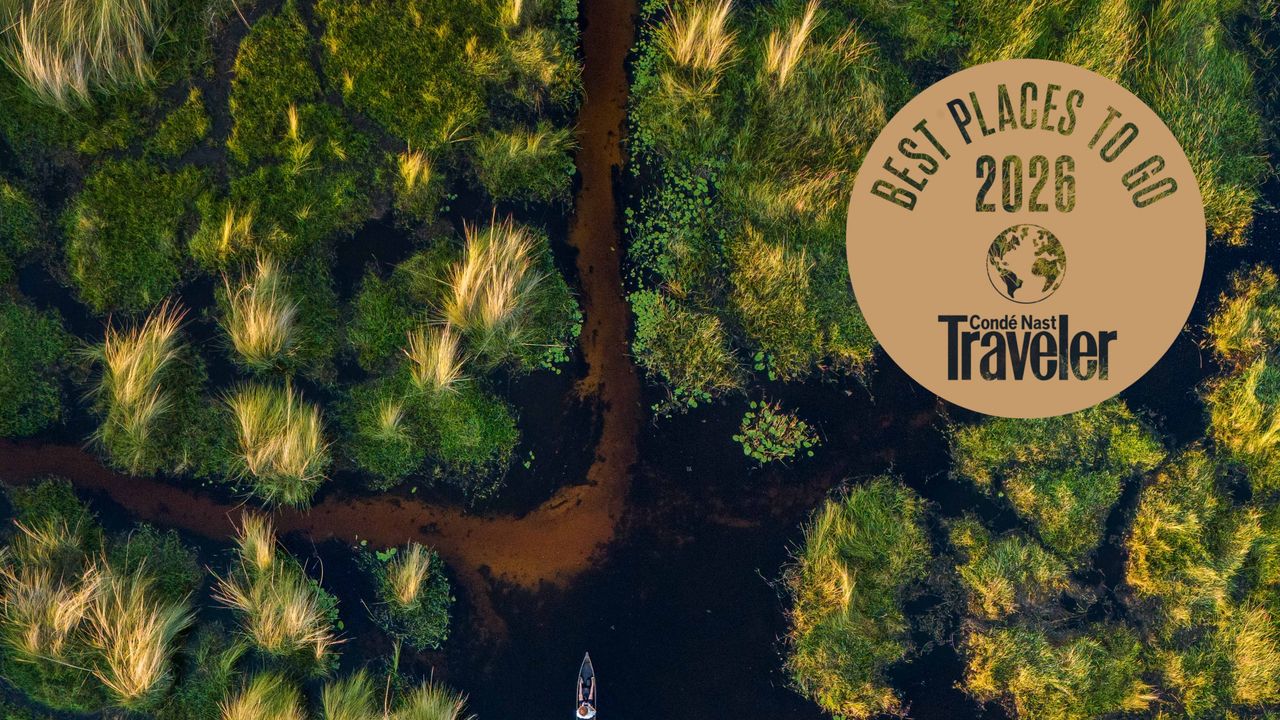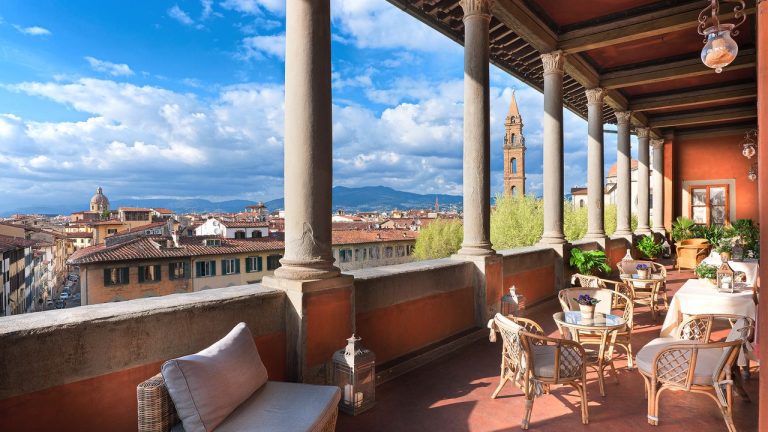For ancient medinas, unspoiled archipelagos, and safaris without the crowds.
-lede-story-stamp.jpg)
Nkasa Linyanti
All products and listings featured on Condé Nast Traveler are independently selected by our editors. However, we may receive compensation from retailers and/or from purchases of products through these links.
One of the thrills of editing this list each year is being able to tap into our network of writers across Africa and beyond who are so eager to shine a light on the diversity of experiences throughout the continent. Of course, they put plenty of exciting new safari lodges on our radar—among them, hotly anticipated openings in beloved regions like Botswana’s Okavango Delta, a clutch of stylish new lodges scattered across the remote reaches of northern Namibia, and untrammeled national parks in Angola. But we’re just as excited to have new reasons to visit the adventure capital of Victoria Falls, Zimbabwe; get lost in the ancient medinas of Fès, Morocco, currently in the throes of a massive restoration effort; sink our toes into the pristine white sands of coastal Mozambique; and discover an emerging creative neighborhood on our next spin through Nairobi, Kenya. And then there’s Algeria. Africa’s largest country, once one of the most closed-off nations in the world, is beckoning travelers at last. Curious to add it to your 2026 travel wish list? Read on to find out more. —Sarah Khan
This is part of our global guide to the Best Places to Go in 2026—find more travel inspiration here.
The Best Places to Go in Africa in 2026
Algeria
Go for: a famously tough-to-get-to destination that’s finally opening up
Algeria—and its hundreds of miles of Mediterranean coastline—will be more accessible to visitors than ever in 2026, thanks to new hotels and tours.
Getty
As Africa’s largest country by area, Algeria has loads for tourists to discover, from its swath of the Sahara and rock-art-studded mountains to Islamic architecture, Roman ruins, and Mediterranean beaches. So why is Algeria so rarely visited, especially compared with its North African neighbors Morocco and Tunisia? One reason has been a complex visa process. But that’s changing. Visas on arrival have been introduced for the southern Sahara region, and there are plans to roll out electronic visas for the whole country—part of a “master plan” to boost tourism fourfold by 2030, continuing an uptick in arrivals over the past couple of years. British small-group tour company Explore Worldwide has latched onto this, introducing its first Algeria tours, which will launch in early 2026: One is based in the Sahara, visiting ancient rock-art sites and wild camping in the desert; another’s centered on the capital, Algiers, and historic centers; and a 16-day tour combines the desert and cities. Meanwhile, national carrier Air Algérie recently acquired domestic Tassili Airlines to improve intra-country connections; invested in new planes, the first of which will arrive in 2026; and roll out several new international routes (New York is in the cards but not yet confirmed). And there are a bunch of hotels under construction, including Grand Hôtel Cirta—opened in 1912, it’s housed in a grand, white Arab-Moorish-style building in one of the world’s oldest cities, Constantine. The hotel closed for refurbishment in 2014 and is rumored to finally reopen in 2026. —Heather Richardson
Angola
Go for: a new international airport and safaris without the crowds

Angola’s national parks offer a more intimate safari experience than many of its Southern African neighbors, and new camp openings will provide unparalleled access to the region’s elephants, cheetahs, and rare birds.
Stefan van Wyk
For decades Angola was inaccessible to international visitors due to rolling civil wars and strict visa policies. But this spectacular southern African country almost twice the size of Texas is finally starting to open up. Plans are currently underway to host international flights from its new Dr. António Agostinho Neto International Airport, and US citizens can stay for up to 30 days. Expected long-haul flights will travel to the capital, Luanda, from Lisbon, São Paulo, and African destinations for now, but national operator TAAG Angola Airlines is planning a direct route from Houston in 2027.
Safaris in Angola deliver a contrasting experience to busy parks in other parts of southern Africa. Here it’ll likely be just your 4×4 and the cheetahs, elephants, and rare birds. Iona National Park is debuting its very first tented camp in 2026 with a capacity of 10 beds, and Cuatir Nature Reserve, which is expanding to become a 500,000-acre private park 932 miles from Luanda, is building a more comfortable wood-and-brick tented camp. Visit either park, and stay at the five-star Mumba Lodge on one of three new Angola itineraries from Untamed Travelling. Hilton is also opening a 210-apartment DoubleTree on the Cabinda coast, and Sheraton is constructing a 326-room hotel in Luanda. —Joel Balsam
Arusha, Tanzania
Go for: a beloved icon’s opening in the city, and a new camp’s take on safari in the forest

With new boutiques, much-anticipated hotels, and a primatology center dedicated to the late Dr. Jane Goodall, Arusha is becoming one of Tanzania’s most exciting destinations.
Elsa Young
Rumors of the late primatologist Jane Goodall’s new museum in the city of Arusha have circulated for months—and now, finally, they’re confirmed. Dr. Jane’s Dream: The Goodall Centre for Hope will open in late October 2026, next to the centrally located Arusha Cultural Heritage Center. Created by a team of designers who include an alumnus of Disney’s Animal Kingdom, the space will consist of six interactive exhibit areas—including a theater and a Garden of Commitment—focusing on conservation education for future generations.
While the city received media attention recently in light of 2025 election demonstrations, Arusha is abuzz with other goings-on, too, courtesy of local entrepreneurs, from Afro-minimalist Makao Collective, which curates gorgeous handcrafted furniture and home decor, to Opuk Lounge, which makes delicious boxed-picnic lunches for conservation-focused safari outings with The Wild Source. Sports enthusiasts, take note: The 30,000-seat Samia Suluhu Hassan soccer stadium in Arusha’s Olomoti region will open in the summer of 2026, primed to host the 2027 Africa Cup of Nations final.
Looking beyond the city, the much-anticipated Koroi Forest Camp from Entara, a community-focused operator, opened this summer in Arusha National Park. This eight-chalet property in the Momella Forest, on the lower slopes of Mount Meru, gives a distinct alternative to the classic game viewing of Tanzania’s plains; instead, here, you might see elephants, shy duikers, and the black-and-white colobus monkeys that give the camp its name. Another newcomer to the safari scene is the Laba Mama Simba, which opened this spring in the 1,730-acre North Dolly wildlife estate. —Samantha Falewée
Bazaruto and Vilanculos, Mozambique
Go for: barefoot-luxury island lodges, new bush-to-beach flight routes, and seahorse snorkeling

In a region visited mostly for its safaris, Mozambique’s Vilanculos and the Bazaruto Archipelago are luring travelers with buzzy new hotels and some of the best beaches you can find.
Viila Saudade
Mozambique’s Vilanculos and the Bazaruto Archipelago are set for a standout 2026. The launch of Safari Air’s Gorongosa–Beira–Vilanculos route in June 2025 finally makes a safari and sea pairing seamless: pangolins and elephants in the morning, sundowners with your toes in the sand by evening. On Benguerra Island, Azura Marlin Beach reemerged in July 2025: It’s a crisp, contemporary escape of just 10 villas (including a showstopping Villa Vista with a private pool), all at barefoot-luxury standard but at the best-value price point on the island.
On the mainland, in June 2025, the minimal-chic Sussurro unveiled a spacious family suite and a romantic Mutukwa Picnic, for which guests are whisked to their own private sandbank amid floating forests. To explore the mainland markets and the relaxed vibe of Vilanculos, Saudade offers attentive owners with over 25 years of local experience. Book one of the six design-led rooms for a romantic escape–or for larger gatherings, the property can be paired with neighboring Villa Coco (three suites and a family room) to host up to 24 guests for a celebration. Don’t miss the guided traditional dhow tour through Mangalisse Bay and snorkeling for seahorses (there are three endemic species!) in the endangered seagrass meadows, followed by a home-cooked matapa lunch.
Not far away, the exclusive-use Pambele beach house (owned by the same conservation-minded family behind Botswana’s renowned Mashatu Game Reserve), inside the Vilanculos Coastal Wildlife Sanctuary, relaunched in August 2025 and now welcomes groups with all-included activities, from kayaking and birding to dolphin-spotting boat trips. And there could be much splashier news ahead: Rumor has it safari stalwart Singita has lately been scouting locations in Mozambique for a future project. —Melanie van Zyl
Fès, Morocco
Go for: a slate of ambitious restoration projects breathing new life into the historic city
Fès will welcome gilded reopenings in 2026 including an ambitious restoration of its medieval medina.
Getty
Fès is Morocco’s cultural capital and intellectual center, but it still flies beneath the radar. That looks set to change in 2026 with the long-awaited reopening of Palais Jamaï—Fès’s iconic heritage hotel built in 1879 by a grand vizier to the sultan—after a decade-long renovation. A sister property to Marrakech’s landmark La Mamounia, Palais Jamaï is one of only a handful of centenarian North African hotels and retains its opulent architectural form, plus an atmosphere thick with history.
The gilded reopening is the cherry on the cake of a decades-long renovation of the world’s largest, most intact medieval medina that has reinforced several thousand rammed-earth structures as well as restored many of the city’s most significant monuments. First among these is the ninth-century Qarawiyyin Library in the world’s oldest university, while Place Lalla Yeddouna—a riverside neighborhood rehabilitated by architects Michel Mossessian and Yassir Khalil—was shortlisted for the 2025 Aga Khan Award for Architecture. Then there are the beautiful 14th- and 15th-century fonduks (trading houses) of Chemmaine, Sbitryine, and Barka, restored as gorgeous artisan workshops focused on high-quality local crafts. Fonduk Kaat Smen will join them before the end of 2026, reopening its doors to a unique historic honey market. The Al Batha Museum of Islamic Arts, now Morocco’s finest museum, also quietly reopened recently; it offers a well-curated overview of the country’s dynastic history by using exquisite artifacts and illuminated manuscripts that place Fès in the context of a wide web of Mediterranean and African relationships. Those connections are evident at the Fès Festival of World Sacred Music, which takes place annually in May and June and celebrates Fès’s role as a center of Sufi mysticism, Islamic scholarship, and Andalusian musical heritage. Also on deck for 2026: The city kicks off the year hosting Africa Cup of Nations matches, and awaits a near-total solar eclipse in August. —Paula Hardy
Gabon
Go for: pristine African rainforest meeting the sea; an immersive, active alternative to game-drive safaris; the wonder of isolation

Gabon, home to “Africa’s Last Eden”, might just be the most exciting wildlife-viewing destination this year—where else can you see gorillas, humpback whales, and surfing hippos on the same trip?
Iniva Tourism & Hospitality
Gabon’s tourism industry might still be in its infancy, but 2026 will see it emerge as Africa’s (and arguably the world’s) most exhilarating rainforest destination with the January opening of Loango Savannah Camp. Located on the iconic Iguela Lagoon—where forest elephants splash en route to a coastline made famous by Gabon’s surfing hippos—this new tented camp is one of three properties in the northern part of Loango National Park. Dubbed Africa’s Last Eden, Loango—a wonderland of pristine forest, savannah, and lagoons pouring into the wild Atlantic—offers, among other things, what some insiders are calling the best gorilla trekking experience in Africa.
If three lodges are two too many, head south to Moukalaba-DouDou National Park, where Nyanga Lodge, which opened in early 2025, enjoys sweet isolation as the sole luxury safari property in what locals refer to as the “great apes national park.” Nyanga’s offerings for 2026 include outdoor dining experiences from a new treetop terrace to beach dinners, all the better to spy one of the park’s many primate species or marine spectacles like migrating humpback whales and nesting sea turtles. With its surrounding waters also rich in game fish like tarpon, Nyanga will additionally launch the first full season of its exclusive international catch-and-release sport fishery in 2026.
For those seeking an even wilder experience, the early 2026 opening of Sette Cama Eco Camp at the remote southern end of Loango National Park promises to be a game changer. The first property in Machaba Safaris’ Machaba Wild portfolio, this comfortable base camp will focus on adventures that favor immersion over indulgence. With activities like jungle treks (tracking chimpanzees, western lowland gorillas, forest elephants, and red river hogs), longer coastal trails (the best way to see the same jungle creatures on the beach as well as surfing hippos), and boat cruises and kayaking trips (ideal for spotting dwarf crocodiles, incredible bird life, and the shyer West African manatees), it’s all about active engagement with Gabon’s extraordinary environments. Perhaps the ultimate and most intimate version of jungle immersion, Lowveld Trails Co. will launch its first full-season of multinight primitive walking trails in mid-late summer 2026, using Sette Cama Eco Camp as its base.
While Gabon’s wonders are both unique and abundant, tourism infrastructure remains rudimentary at best, and great wildlife sightings are not always easy. With Anderson Expeditions, a pioneer in conservation-forward tourism in Gabon, resuming its tailored itineraries in 2026, private guides will help guests navigate the primeval forests and crystalline streams. —Lee Middleton
Ngara, Nairobi, Kenya
Go for: an urban enclave offering a bold, walkable slice of Nairobi’s food, fashion, and art scenes

Ngara is a bona fide creative hub, with its vibrant arts and music scene drawing comparisons to New York’s Lower East Side.
The Living Rooms
New upscale restaurants in Ngara are celebrating pan-African cuisine while bringing an elevated touch.
TEAGAN CUNNIFFE/Hemingways Collection
Once a chaotic public transport hub wedged between downtown Nairobi and the leafier suburbs, Ngara is fast becoming East Africa’s creative hot spot. Part of the district, which is roughly the length of two New York City blocks, is undergoing a renaissance powered by African fashion, food, and art.
The inner-city neighborhood was originally (informally) carved aside for Indian traders during the colonial period, and characterized by its sprawling rows of dukas—two-story shop fronts where traders sold spices downstairs and lived upstairs with their families. As the merchants grew prosperous and moved into greener outer neighborhoods, the area declined and slipped into neglect. Today it’s staging one of the city’s most exciting cultural comebacks. In 2026, several buzzy openings will cement its transformation. Refettorio Nairobi, a hybrid dining concept from Michelin-starred chef Massimo Bottura, will serve two meals a day—one for the less privileged and one for paying guests. And 50 Golborne, the acclaimed London gallery, launches its first African outpost with a solo show by Ugandan artist Sanaa Gateja. Ngara is drawing comparisons to such global enclaves as Shoreditch and the Lower East Side. It’s anchored by cultural landmarks including the Sarakasi Dome, one of Nairobi’s oldest cinemas, and fueled by homegrown indie spots like Soma Nami Books, The Living Rooms, a stylish social club. Head to Ngara to experience Nairobi’s cultural zeitgeist: vibrant, communal, and unapologetically pan-African. —Sharon Machira
Northern Namibia
Go for: haute-design newcomers and a rumored influx of rhinos

The dry swathes of Northern Namibia’s deserts provide a uniquely striking backdrop for viewing the region’s rich wildlife.
Natural Selection

Nkasa Linyanti is one of a slate of luxe new safari camps arriving in the region, providing incredible access to wild, untouched wetlands.
Natural Selection
The strikingly hued Sossusvlei salt pans of the Namib Desert have long captured travelers’ attention, but the northern reaches of Namibia will entrance design devotees in 2026. Vestige Collection, known for its carefully appointed boutique hotels and private estates in Spain, is launching four lodges, one in the summer of 2026 and the remaining by the end of the year, in destinations ranging from Damaraland, where desert-adapted lions and red hartebeest roam, to the little-visited Khaudum National Park—all accompanied by a heightened sense of style. Elusive black rhinos can be spotted in places like the Grootberg mountains, but hopes are high that travelers will begin seeing white rhinos in such places as Etosha National Park, another site of a Vestige Collection lodge, as African Parks develops plans to distribute the mighty animals from its Rhino Rewild project.
Two properties from Natural Selection are also debuting in May 2026. One is Hoanib Elephant Camp, a solar-energy-powered camp of 10 rooms, where visitors can look for elephants in the Kaokoland desert, and the other is Nkasa Linyanti, a six-room camp on Nkasa Island in the heart of the Kavango-Zambezi Transfrontier Conservation Area. In early 2026, keep an eye out, too, for Thitaka Lodge, the first Namibia property from the Cape Town–based Newmark Hotels & Reserves group, in Bwabwata National Park. O&L Leisure’s Mokuti Etosha, on the edge of Etosha National Park, has just launched SkyBoma, an open-air dining venue some 26 feet off the ground that will offer Namibian cuisine paired with stargazing. It’s a remarkable wave of high-style properties coming to Namibia—and heralds a new chapter for the country’s future of safari. —Samantha Falewée
Okavango Delta, Botswana
Go for: plush new lodges in one of Africa’s most sought-after corners
It’s raining new lodges—and immersive experiences—in Okavango Delta in 2026, cementing its reputation as one of the best safari destinations on Earth.
Karangoma
Pula, they call it, a polysemous Setswana word for rain, but also blessing and money. Botswana’s most valued currency fell long and hard in 2025, the highest flood levels since 2017 carving fresh waterways and seeding new life in the game-rich Delta. Whether you’ve not yet been, or are dreaming to return, 2026 is the year to do so.
It’s also the year that sees luxury safari outfitter Singita’s first foray into the Delta. Opening in December in a 170,000-hectare concession, Singita Elela will have five one-bedroom exclusive-use camps, each serviced by a personal team, plus two two-bedroom and four-bedroom camps (from $3,100 per person). Offering similar exclusivity at the other end of the price spectrum, Karangoma Lagoon launches in April with rates starting from $480 per person. Comprising four tents on the remote Magwegqana Channel, it’s reachable only by chopper (capitalizing on the growing demand for helicopter transfers, Helicopter Horizons brings another Bell 407 online in 2026). Following the trend for small, immersive camps, Di Di Metsi, a four-tent camp built by Clyde Niven (who recently refurbed Cha Cha Metsi), opens in May; with no roads, it will be accessed only by boat or helicopter. Having secured another 15-year-lease in Linyanti, African Bush Camps are building their second Icon Camp in Botswana: the new Linyanti Ebony will cater for a maximum of 24 guests, cocooned in the same luxury as Atzaró. Another Delta blessing is Sediba Sa Rona, opening in March 2026. A complete overhaul but using the original footprint of the iconic Khwai River Lodge, Desert & Delta Safaris have given the grande dame of Khwai an elegant makeover, capitalizing on her fabulous location. Wherever you stay, just being in the Delta, so lush after the record-breaking pula, is to experience an intravenous hit of pure, unadulterated joy. —Pippa de Bruyn
Victoria Falls, Zimbabwe
Go for: a slew of new hotels offering fresh vantage points to experience the iconic falls and Africa’s adventure capital

New lodgings like Mpala Jena offer a stylish refuge at—and easy access to—the iconic Victoria Falls.
Great Plains Conservation
Long celebrated for the Mosi-oa-Tunya—“the smoke that thunders”—the city of Victoria Falls is reinventing itself as one of southern Africa’s most exciting destinations in 2026. Travelers come not just to behold the falls but for the adventure, culture, and conservation experiences. And a spate of new hotels have arrived to meet the demand, including Anantara’s first Zimbabwean property, the plush Stanley & Livingstone Victoria Falls, which debuted last December; adventure operator Wild Horizons’ Waterfalls Lodge, which followed in July; and Samanzi Luxury Cabanas, a boutique retreat that opened in August with intimate cabanas and tranquil pools. This past June the Palm River Hotel unveiled a stunning new riverside deck that overlooks the Zambezi, offering scenic dining experiences and a beautifully curated high tea. Looking ahead, Bupenyu Lodge by Newmark Hotels & Reserves (opening at the end of this year) and the House of Chinhara–Vignette Collection (opening in January 2026) promise ultra-luxury options that will transform the region from a stopover to a destination in its own right. In addition, the new Mpala Jena Private Villas, set on the sandy banks of the Zambezi, offers a secluded and fully powered three-suite sanctuary with private pools, riverfront suites, personalized butler and guide services, and easy access to the falls by road or boat. Infrastructure is also keeping pace with this growth as the Bulawayo-Victoria Falls highway is under rehabilitation, Fastjet has just launched the new Bulawayo-Victoria Falls route, and the construction of the Mosi-oa-Tunya International Cricket Stadium, poised to host the 2026 ICC under-19 World Cup, is underway. —Harriet Akinyi








